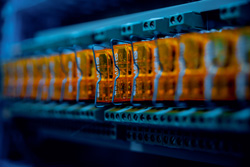Box Builds
What are Ingress Protection Ratings and Why Do They Matter?
by Rittal North America LLC
When you need a product that houses dust and temperature-sensitive objects like electrical equipment, it’s important to understand what elemental factors it will need to withstand. Will it be on a boat, subject to spraying water? Will it be housed in a data center and subject to dust exposure over time? This is where Ingress Protection (IP) ratings come in — to help you find the right enclosure for your needs.
What are ingress protection ratings?
Ingress protection ratings measure resistance to environmental factors like water and dust. This standard has been adopted across many industries, such as food and beverage and automotive, due to its simplicity and efficiency. You may have seen IP and NEMA ratings (see What is NEMA, May/June 2020 on WWW.wiringharnessnews.com)going hand-in-hand. Both are guides for choosing the right level of protection against risks to your valuable components, but whereas NEMA rating is the standard in the United States and Canada, IP ratings are the international standard. A universal IP system is especially helpful because it gives manufacturers and users a consistent way of tracking how safe an enclosure will be based on the elements that it needs to withstand over time.
IP ratings in detail
An IP rating is used to provide specific measurements so that you can be confident that the product you’re about to buy will remain functional and safe in your unique environment. IP Ratings are organized by levels of protection. A 0 rating offers no protection at all, while a 6 (for solids) and 8 (for liquids) offer airtight protection.
IP ratings are organized with two digits:
- The first digit refers to solids like dust
- The second digit refers to levels of water resistance
Below is a list to help explain what the numbers in IP ratings mean in greater detail:
IP ratings for solids:
- 0:Not protected
- 1:Protected against objects larger than 50mm, such as a hand
- 2:Protected against objects larger than 12.5mm, such as a finger
- 3:Protected against objects larger than 2.5mm, such as tools and thick wires
- 4:Protected against objects larger than 1mm, such as small wires and screws
- 5:Protected against some dust and complete protection against contact
- 6:Dust tight with total protection against contact
IP ratings for liquids:
- 0:Not protected
- 1:Protected against dripping water from above
- 2:Protected against water drops at up to a 15 degree angle
- 3:Protected against spraying water up to 60 degrees
- 4:Protected against splashing water from any direction or heavy seas
- 5:Protected against mild water jets from any direction
- 6:Protected against powerful water jets (12.5mm nozzle) from any direction
- 7:Protected against immersion up to one meter
- 8:Protected against immersion beyond one meter
Which IP rating is best for my use case?
Let’s say you find an enclosure with an ingress protection rating of IP60. This means that your components are protected completely against dust particles, but are not protected whatsoever against liquids. This enclosure would fit in an environment like a data center that houses electrical equipment.
Keep in mind that higher ratings aren’t necessarily better. For example, if your IP rating is IP67. Your components will be protected against immersion in water up to 1m, but that doesn’t indicate that it provides water protection 1-6 — although your enclosure can be immersed, it may not be able to withstand high-pressure jets.
Furthermore, marking a product as “waterproof” is much more vague than providing an IP rating — it doesn’t provide a clear definition of how much water it can resist. For example, “waterproof” doesn’t tell you whether an enclosure is designed to remain safe through rainy days or while submerged underwater.
A device like a car door should be ingress protected against the spray of water and dust to a certain degree when closed. With that in mind, it’s best to get a device with the IP rating custom-tailored to its use. For example, if you need an enclosure that can protect against harmful dust and water jets in any direction, Rittal’s Baying system TS 8, with its IP rating of 55, could be a fitting choice.
Why IP ratings matter
IP codes are designed to protect items like food, electronic products, and automobiles from damage while ensuring efficiency. For products like a telecommunication or switchgear enclosure, it’s important to determine the expected exposure to the elements throughout its lifetime.
And IP ratings are vital during a product’s design stage — it allows the designer to achieve a set standard, or even improve upon it, depending on the intended purpose. This will help them increase usage and durability significantly. By labeling products with appropriate IP ratings, an organization is able to better describe the applications for their products, which inspires greater credibility.
About Rittal
Rittal is a worldwide leader in climate-control enclosures and innovation. Learn more about Rittal, including our NEMA — and IP-rated — enclosures and our power distribution and climate control solutions. Partner with us to increase your organization’s efficiency and reap the full benefits of Industry 4.0. See their enclosure solutions at www.rittal.com.































































